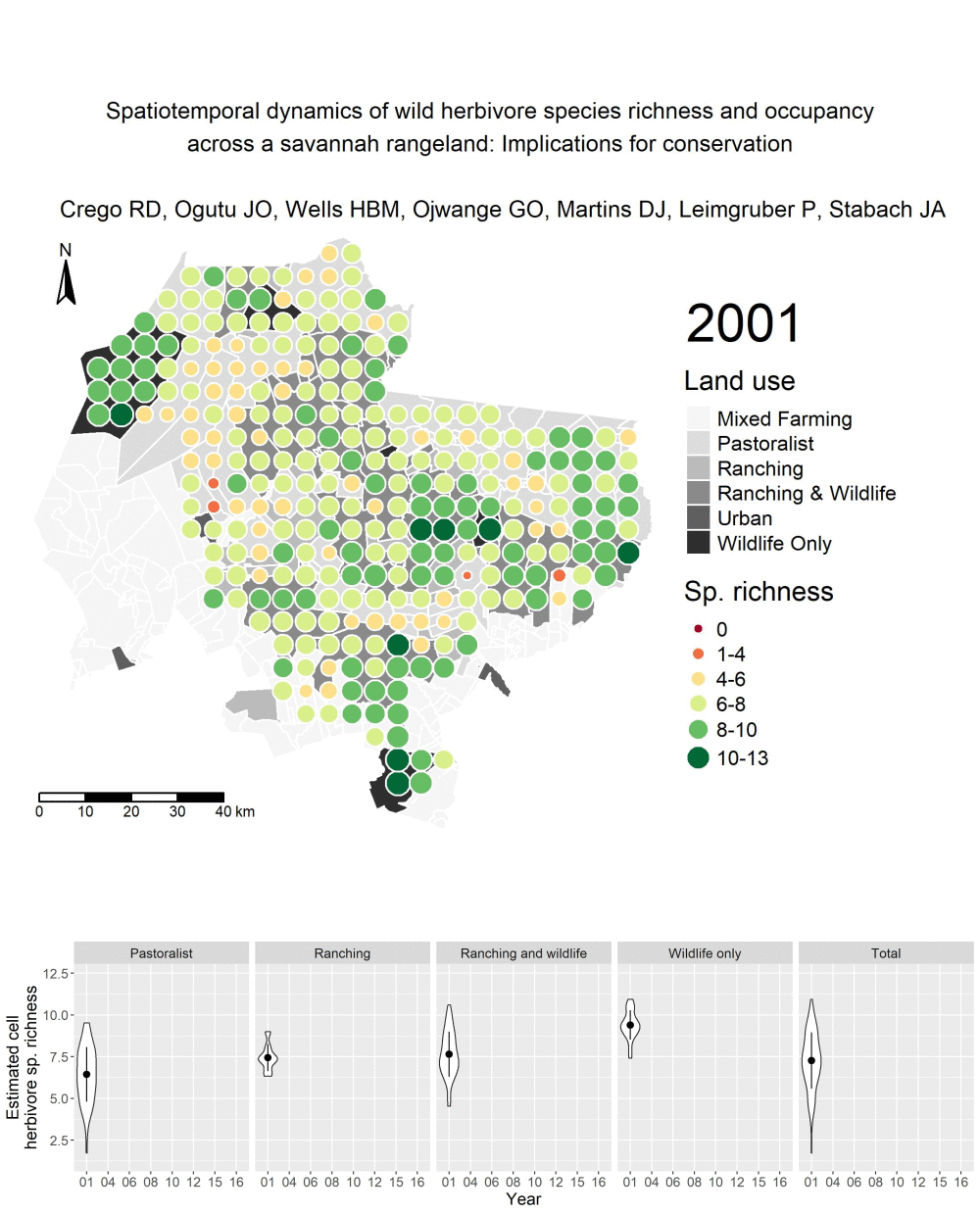

Beyond protected areas: ecology and conservation in communal and private lands of Kenya
I have been an associate researcher at the Smithsonian Conservation Biology Institute (SCBI) since July 2018 under the direction of Dr. Stabach.
Wild herbivores species richness, occupancy dynamics and interactions with livestock abundance
Laikipia County in central Kenya, holds a diverse community of wild herbivores, including many endangered species.
Private and communal lands, outside formal protected areas, are critical for maintaining biodiversity. In Laikipia this means balancing livestock management with conservation needs to ensure coexistence of people and wildlife on private lands.
We collaborated with Mpala Research Centre and Kenya’s Directorate of Resource Surveys and Remote Sensing (DRSRS) to assess wild herbivores spatiotemporal dynamics in species richness and occupancy, and wild herbivore interactions with livestock abundance.
We used novel modeling techniques to re-analyze aerial survey datasets, accounting for detection probability and rare species. We modeled species richness across land uses for the last 20 years.


Our findings highlight consistent trends in species richness and abundance across time and land uses, but with areas managed for wildlife supporting more species than those that are not.
Declines in wildlife richness were directly related to increases in livestock relative abundance.

However, we found that certain pastoralist areas conserve high species richness, showing that livestock and wild herbivores coexist when stock densities are moderate. We expect that results will be highly valuable for local managers to make informed decisions to protect wildlife.
With the help of some novel statistical tools, we were able to include in the study species such as Grevy’s zebra, oryx and gerenuk. These species have been historically difficult to analyze at the regional scale because they are difficult to detect from aerial surveys, especially during the last years as populations of many species declined drastically.
We found that reticulated giraffes, Grevy’s zebras, oryx, Defassa waterbuck and gerenuk, have only occupied less than 50% of Laikpia rangelands during the last twenty years. Increase protection for these species is critical given that all these species face high conservation challenges and Laikipia represent one of the last habitats left for them.


Moving through the mosaic: Identifying critical linkage zones for herbivores in African multiple-use landscapes

One of the main challenges that wildlife populations face across arid rangelands is the increasing number of fences that limit movement.
We paired species richness and occurrence information derived from aerial surveys with fence data and resistance-based connectivity models to investigate landscape connectivity and identify important areas for animal corridors across Laikipia rangelands.
We analyzed landscape connectivity for elephants, giraffe, plains zebra and Grevy's zebra.
We validated resistance layers using telemetry data. animal movement, fences information.
We digitized more than 900 km of fences across the landscape.
With the collaboration of many partners, We are keeping the fence information updated.

We found that aerial surveys can be powerful data to model connectivity and inform conservation planning.
For Laikipia, we found that conservancies in the south and west are being isolated from the center of the landscape by fences, agricultural and degraded areas.

Community level analysis

In our connectivity restoration analysis, we identified 4 areas (brown colors) that are critical for maintaining connectivity across conservancies. This type of map is critical to guide regional management strategies.


Research in the Greater Mara Ecosystem
I led a project to develop an analytical framework to monitor large herbivore populations in wildlife conservancies across the Greater Mara Ecosystem in Kenya, linking advanced hierarchical distance sampling models with remote sensing data. \

This work was the foundation of a NASA grant that was awarded to the Smithsonian Conservation Biology Institute – a grant on which I am an active collaborator. This collaboration seeks to further develop my framework into a tool that can be used by managers to monitor wildlife trends and allocate grazing stocks to pastoralists across conservancies based on available vegetation, thus ensuring the coexistence of wildlife and livestock
Science into management
I have designed a Shiny app to help managers visualize the results of our studies and make decisions on the ground related to livestock management, fence deployment and their effects on herbivore species richness and landscape connectivity, and species abundance.
Click on the images to explore the apps.
Technical capacity building
As part of SCBI, I have been working in collaboration with the Mpala Research Centre in Laikipia County, Kenya, in developing workshops to build regional technical capacity.
-
September, 2018. Spatial analysis technical workshop. I participated in developing a curriculum and teaching on the spatial analysis workshop that took place at the Mpala Research Center, Nanyuki, Kenya. Fourteen researchers from the Institute of Primate Research, Kenya Wildlife Service, Kenya Wildlife Trust, Loisaba Conservancy, Mpala Research Centre, Mugie Conservancy, National Museums of Kenya, and University of Nairobi attended the workshop.


-
November, 2018. Monitoring invasive Opuntia strictainvasion amid herbivory and biocontrol agent. I collaborated with Mpala researcher Kimani Ndung'u, to organize a 1-day field course on monitoring, sampling, and data analysis of an invasive species. Twenty-eight students from the Kenyan Wildlife Service Training Institute participated at the workshop.



